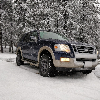Check this:
http://www.explorerforum.com/forums/showthread.php?t=122696
Aloha, Mark
PS...For ball joints, here is some stuff I've kept (from other posts) :
How to check the lower ball joints:
Jack up vehicle and support it under the lower control arm so the wheel is an inch or two off the ground.
Grab the wheel at the 6 and 12 o'clock positions and try to rock the wheel in and out while someone watches the ball joint. There should be no play. If any side to side play in the balljoint is seen, replace it.
Place a pry bar between the floor and the tire and lift up on the pry bar. The ball joint should have very little or no vertical deflection. If the deflection is more than about 1/16", the joints should be replaced. (I've noticed that even new factory joints have some vertical deflection.)
Balljoint life is very dependent upon the driving conditions. My '01 XLS needed to have the lower ball joints replaced at 28K and again at around 40k. Ford uses a non-greasable lower ball joint from the factory, and they don't last very long. When replacing the joints, DO NOT BUY FORD BALL JOINTS!!!! Use a Moog or TRW greasable ball joint and you shouldn't have to replace them again for a long time.
With the tire off the ground, grab the top with one hand and the bottom with the other and see if you can induce play by pulling and pushing on the tire with both hands at the same time, one hand pulling out while the other hand pushes in, and vice versa. It should feel pretty tight. If not, voila!, bad ball joint. You should be able to feel which one is bad, upper or lower.
You're right in saying that if you replace one, do the other at the same time.
What would really be nice is if you had someone that is experienced with checking ball joints so they could make sure your diagnosis is correct. If you don't know anyone personally, any front end shop should be able to check your ball joints for you for nothing or a minimal fee and also you can watch them and see how they check them.
_____________________________________
_____________________________________
Here was what I did, It took right around an hour.
-We start on jackstands with no tire and nothing under the control arm yet.
-Remove all braking components
-Remove sway bar end links
-Remove axle nut
-Remove Hub/Bearing assembly
-Disconnect TRE
-Push stub axle back through the hole in the spindle and out of your way
-Remove cotter pin and castle nut from Lower BJ
-A few quick hit's with a 1 pound deadblow released the BJ from the spindle (strike the control arm)
-Grab the trusty BJ Press and propane torch.
-I put as muh pressure on the BJ as I could get with the press and an Impact wrench
-I then aimed the torch at the area and leaned back to have a smoke
-By the time my cig was done the BJ had begun to move on it's own and was relatively easy to press in.
-Let the area cool back down some before replacing with new part
-To press the New BJ In I found that it was easier to take my floor jack and fit the install cup from the BJ Press on it. The lift up on the bottom of the BJ I had started by hand. It won't press in all the way like this , but once you start to lift the whole vehicle rather than the control arm, get that trusty 1 pound deadblow back out and start tapping the control arm in a circular motion around the BJ. The vehicle weight combined with the tapping pressed them in a lot easier than the press.
P.S. Don't forget that the BJ boot has a notch in it which faces in.
__________________
http://www.haroh.com/explorer/ball_joint.html
________________
http://www.explorerforum.com/forums/showthread.php?t=149449&highlight=ball+joint+tools
____________________
____________________











